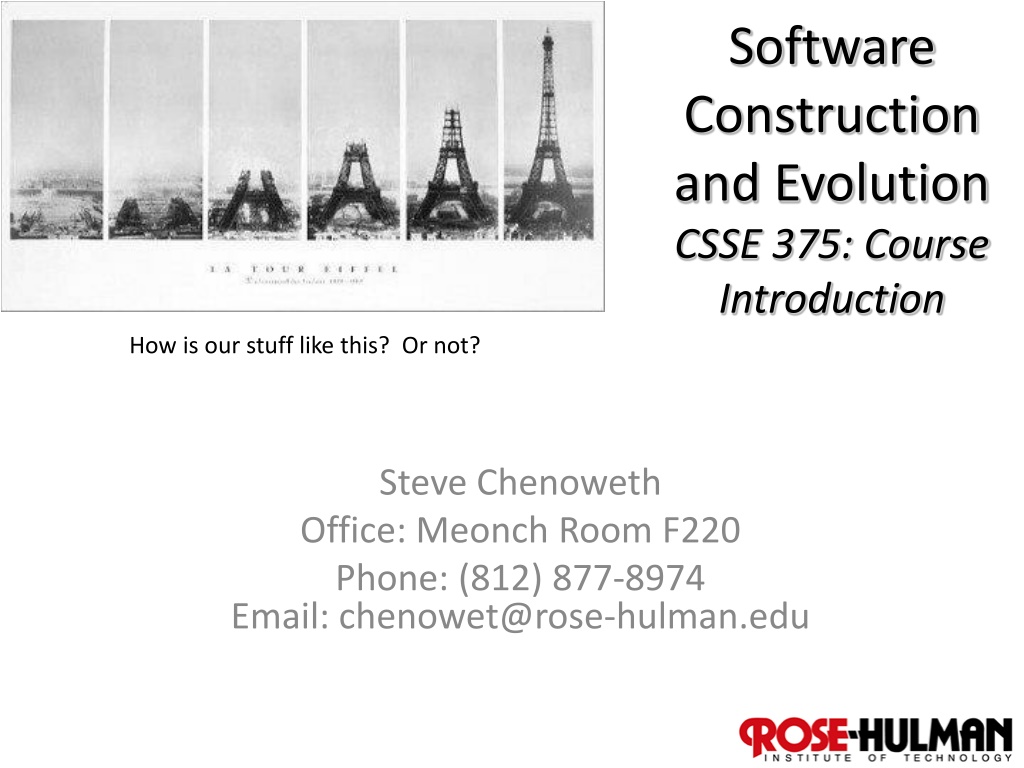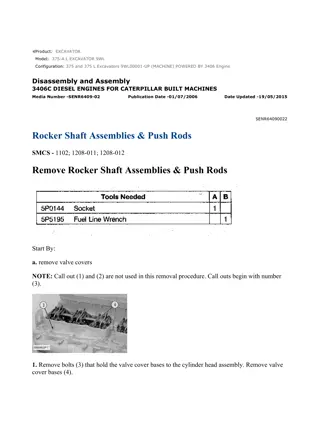Software Construction and Evolution in CSSE 375: Overview
"This course introduction in Software Construction and Evolution (CSSE 375) covers topics such as the nature of software, challenges in software evolution, software degradation, and the art of avoiding information loss due to relentless changes. The course aims to equip students with skills in software maintenance, modernization, and configuration management, among other advanced topics."
Download Presentation

Please find below an Image/Link to download the presentation.
The content on the website is provided AS IS for your information and personal use only. It may not be sold, licensed, or shared on other websites without obtaining consent from the author. Download presentation by click this link. If you encounter any issues during the download, it is possible that the publisher has removed the file from their server.
E N D
Presentation Transcript
Software Construction and Evolution CSSE 375: Course Introduction How is our stuff like this? Or not? Steve Chenoweth Office: Meonch Room F220 Phone: (812) 877-8974 Email: chenowet@rose-hulman.edu
Agenda Introductions Software A Problem of Change Course Outcomes Guidelines and Expectations Term Schedule Homework Reminders
Introductions Tell us About Yourself Name Major System Maintenance Experience Oldest system you have made changes to (either individually or with a team) Weirdest Software Change or Change Request Q1 Candid shot from the Creation Museum, Hebron, KY
What is Software? The source code and the software artifacts Software is part of a computer system that is intended to change Software is suppose to change Intangible Engineered, not manufactured otherwise it would in the hardware! Complex Q2
Software Doesnt Wear Out Software doesn t change with age or wear out with use! Software ages or becomes obsolete with a changing environment Software deteriorates or degrades with continued changes Q3
Problem: Software Degradation ...Plus a few Changes The Original Software Design... Increased size and complexity ...but it works (for awhile) Easy to Understand Components well isolated to facilitate change Reliability of system degrades, errors creep in Isolation supports change validation At some point, it s unmaintainable ...effort to make the next change becomes prohibitive Q4
Information Lose Due to Relentless Change Change Set 1 Change Set 2 Change Set N Baseline Code Design Spec s
Course Theme Art of avoiding That! Basic principles of software change Program understanding and tools Detecting bad smells Applying software refactoring Exception handling for fault tolerance Software maintenance Software modernization (reengineering) Software configuration management Software user and system documentation Adv. Topics: Impact Analysis, code tuning Course Topics 8
Learning Outcome 1 : Practicing software change Work with your ( big ) junior project team to complete and deliver the junior project to the client. In doing so, demonstrate the ability to work within a team. Woah, client! Q5
Learning Outcome 2: Smells, Refactor to Solve Problems Select appropriate refactoring techniques to resolve design problems smelt in the code. Q5
Learning Outcome 3: Program understanding and tools Apply common construction and maintenance heuristics to enhance existing code. Q5 11
Learning Outcome 4: Really Needed Documentation Organize and develop software stakeholder documentation. Who are these guys, on your project, anyway? Q5
Learning Outcomes 5 : Basic principles of software change Construct software so that it meets delivery and deployment objectives specified by the project. Stop coding here he comes! Q5
Learning Outcomes 6: Maintenance Planning and Apply impact analysis and other software source analysis to understanding existing software. How many ducks to we have to line up here? Q5
Learning Outcomes 6: Maintenance Process Apply the corrective, perfective, adaptive and preventive types of software changes and maintenance types. Wait Footprints are supposed to be depressions? Q5
Learning Outcome 7: Change Impacts Apply impact analysis and other software source analysis to understanding existing software. Q5
Learning Outcome 8: Exception handling for fault tolerance Use systematic exception handling and other techniques in promoting fault- tolerance. Wait what letter was I on? Q5 17
Learning Outcome 9: Reengineering Describe software modernization approaches such as reverse engineering, reengineering, salvaging, and restructuring. It says here to connect it to the building across the street Q5
Learning Outcome 10: Software configuration management Describe the ways configuration management is used in production systems. I can actually prove that rearranging these blocks is NP-hard. Q5 19
Course Mechanics Taught in 3 Sections, Sec 1 (Shawn), Sec 2 & 3 (Steve) Find most material: http://www.rose-hulman.edu/class/csse/csse375/ Grades and assignment drop boxes will be on Moodle Put Q 1 for today there, by the end of class. See syllabus and schedule Q6,7























